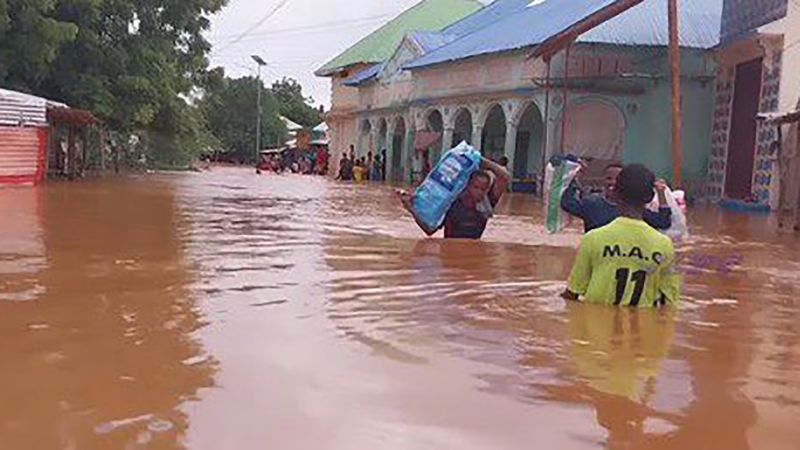
Widespread Devastation: Heavy Rains Leave Over 300 Dead in East Africa

Devastating floods claim hundreds of lives and displace millions in East Africa, intensifying the risk of water-borne diseases
Torrential rains and flash floods have devastated parts of East Africa, resulting in the deaths of over 350 people and displacing more than 1 million in Somalia, Kenya, Ethiopia, and Tanzania.
In Kenya, the Interior Ministry has reported at least 136 deaths and nearly half a million people displaced. President William Ruto disclosed that 38 out of 47 counties in the country have been impacted by persistent rains since October, leading to flash floods, widespread flooding, and mudslides.
The worst-affected areas in the country are the northeastern regions and the eastern coast, where homes and infrastructure have suffered severe damage. Cargo rail services from the port of Mombasa were also disrupted last month. The exceptionally heavy rains are attributed to the El Niño weather phenomenon and are projected to persist into the new year, according to the Kenya Meteorological Department.
El Niño is a climate pattern that originates in the Pacific Ocean along the equator and impacts weather globally. It has been linked to severe flooding in eastern Africa, leading to landslides, waterborne diseases, and food shortages. Meanwhile, the northern and southern regions of the continent often face prolonged drought during El Niño events.
The Horn of Africa is also one of the world's most vulnerable regions to climate change. As the Earth warms, the region is expected to receive less rain overall annually, but heavy rainfall events are projected to become more frequent and intense. This means the Horn of Africa may experience both more drought and more floods from heavy rain.
President Ruto has mobilized the National Disaster Operation Center for emergency response. The Interior Ministry announced a decrease in rainfall expected in northern Kenya this week. At the COP28 in Dubai, Ruto highlighted the impact of climate change, citing the recent catastrophic rains as evidence.
"The situation in our Horn of Africa region, like many other developing countries, lays bare the harsh reality of climate change," he said.
Either way people suffer
The region experienced its worst drought in 40 years just months before the extreme flooding. "We were dealing with severe drought not long ago, and now we're facing issues with excessive water. The people are constantly feeling the strain of these dual impacts," said Abdulkadir Afi, Director of Communication for the Somali Red Cross, in an interview with CNN.
"Whether theres less water or too much water, either way, people suffer," Afi added.
Heavy rains and flash floods across the country have displaced thousands of people.
sntvnews1/X
Severe flooding in Somalia and Ethiopia has left thousands stranded, with the death toll reaching 110 in Somalia and 57 in Ethiopia, as reported by the United Nations humanitarian agency (OCHA). The heavy rains continue to cause widespread devastation in the region.
Northern Tanzania has reported 49 fatalities due to floods and mudslides caused by heavy rains in Manyara province. Manyara governor Queen Sendiga stated that 85 people have also been injured in the incident, according to state media reports on Monday.
Tanzania's President Samia Suluhu Hassan has instructed response agencies to assist in rescuing and preventing future disasters. In eastern Kenya, the heavy rainfall has caused extensive damage to the Dadaab Refugee Camp, which houses around 300,000 refugees. The camp has seen a large influx of new arrivals over the past three years, with many fleeing food insecurity and drought in Somalia.
Surge of water-borne diseases
In November, in Hagadera, a camp within the Dadaab complex, three out of the 15 blocks of homes were inundated, resulting in approximately 20,000 people—about 13% of the camp population—being displaced and seeking shelter in schools and places of worship, as reported by the International Rescue Committee (IRC).
Aid organizations have documented increases in waterborne illnesses such as cholera and acute watery diarrhea, attributable to damaged latrines and limited access to safe drinking water. The IRC reports that relief operations have been impeded by damaged roads, making it difficult to deliver essential supplies like food, clean water, and medical assistance to the most severely affected areas of the camp.
"Its a poignant reminder of its disproportionate impact and a call to action for all of us to mobilize rapidly to address this imbalance with urgency, solidarity, and inclusivity."








